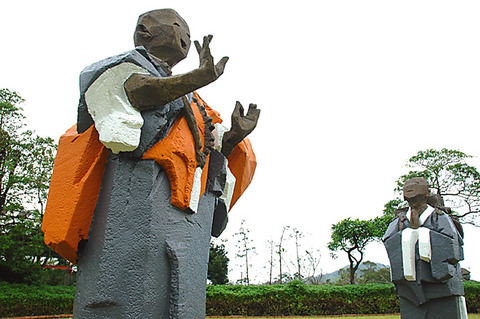Ju Ming (朱銘) is well known for his sculptures, created in bronze, clay and wood, but some people may have overlooked the fact that he is a painter too.
From the beginning of this month, the Juming Museum is presenting many of Ju's newest works in the Living World Series-Monk exhibition. It offers a rare opportunity for the public to take a peek at the mind of this grand master of art.
Ju sketches monks by using charcoal pencil or ink, occasionally coloring them lightly, and applies his technique in collage works to put a different twist on traditional ink paintings.

PHOTO COURTESY OF JUMING MUSEUM
Ju also adopts the collage technique, working with yellow and orange crepe paper to create a simple elegance with geometrical shapes. By combining different art mediums and using Chinese and Western techniques, Ju's New Ink Painting was born.
"Art is cultivation and without cultivation, the flowers from the hearts can never blossom," Ju answered when asked about the source of his vitality. What Ju means is that cultivation does not refer to some abstruse Buddhist philosophy, but daily comprehension of hows and whys and taking the effort to carry it out.
Born in 1938 in a small Miaoli County town, Ju gained international fame and then dedicated 12 years of his life to build Juming Museum, by investing almost all of his money in 11 hectares of land in Chinsan (金山), Taipei County. In 1999 this legendary gallery was founded. The museum "is home to an integral collection of Ju's work throughout his career," said Calvin Ju (
At 15, Ju was trained for three years in traditional temple wood-carving. In 1968, he was under renowned sculptor and modernist Yuyu Yang's (
In 1976, Ju's "raw yet refined treatment," as Calvin Ju describes it, of his wood sculptures won him great fame after an exhibition held at the National Museum of History in Taipei.
According to Lai Shen-chon (賴賢宗), Chinese Language and Literature professor of the National Taipei University, Ju's artistic creations can be divided into three stages: First, his "Nativist Series" is represented by his well-loved sculptures of water buffalos and historical figures such as Guan Gong (
Third, his favorite "Living World Series" explores the many facets of modern life, including his recent inclusion of over 300 bronze statues of war heroes.
"Monk" is the newest art form added to the Living World Series and touches upon self-cultivation. It is, perhaps, the artist's intention to pose the timely question of inner peace, at a time when society is deeply divided.

That US assistance was a model for Taiwan’s spectacular development success was early recognized by policymakers and analysts. In a report to the US Congress for the fiscal year 1962, former President John F. Kennedy noted Taiwan’s “rapid economic growth,” was “producing a substantial net gain in living.” Kennedy had a stake in Taiwan’s achievements and the US’ official development assistance (ODA) in general: In September 1961, his entreaty to make the 1960s a “decade of development,” and an accompanying proposal for dedicated legislation to this end, had been formalized by congressional passage of the Foreign Assistance Act. Two

March 31 to April 6 On May 13, 1950, National Taiwan University Hospital otolaryngologist Su You-peng (蘇友鵬) was summoned to the director’s office. He thought someone had complained about him practicing the violin at night, but when he entered the room, he knew something was terribly wrong. He saw several burly men who appeared to be government secret agents, and three other resident doctors: internist Hsu Chiang (許強), dermatologist Hu Pao-chen (胡寶珍) and ophthalmologist Hu Hsin-lin (胡鑫麟). They were handcuffed, herded onto two jeeps and taken to the Secrecy Bureau (保密局) for questioning. Su was still in his doctor’s robes at

Last week the Democratic Progressive Party (DPP) said that the budget cuts voted for by the China-aligned parties in the legislature, are intended to force the DPP to hike electricity rates. The public would then blame it for the rate hike. It’s fairly clear that the first part of that is correct. Slashing the budget of state-run Taiwan Power Co (Taipower, 台電) is a move intended to cause discontent with the DPP when electricity rates go up. Taipower’s debt, NT$422.9 billion (US$12.78 billion), is one of the numerous permanent crises created by the nation’s construction-industrial state and the developmentalist mentality it

Experts say that the devastating earthquake in Myanmar on Friday was likely the strongest to hit the country in decades, with disaster modeling suggesting thousands could be dead. Automatic assessments from the US Geological Survey (USGS) said the shallow 7.7-magnitude quake northwest of the central Myanmar city of Sagaing triggered a red alert for shaking-related fatalities and economic losses. “High casualties and extensive damage are probable and the disaster is likely widespread,” it said, locating the epicentre near the central Myanmar city of Mandalay, home to more than a million people. Myanmar’s ruling junta said on Saturday morning that the number killed had